
Tacho needles see red as we mark the end of an iconic engine with a rev through Mazda’s rotary history.
First published in the October 2012 issue of Wheels magazine, Australia’s most experienced and most trusted car magazine since 1953.
On Friday, June 22, the last Renesis engine was hand-built in Mazda’s surgically clean rotary assembly room at its Hiroshima plant. When the last of 16 through-bolts that sandwich two rotors and housings between three side plates was tightened, a chapter closed. Meanwhile, I was left wondering if history will record that chapter as four decades of 13B rotary engine production, or half a century of the production rotary-engined car…
Looking at the futuristic four-seater coupe with its suicide doors, idling engine humming a unique tune, it’s hard to believe the RX-8 is now a car of the past. But after nine years in production our 2003 Car of the Year was at the end of its life, and tightening emissions standards had its multi-side-port twin-rotor engine backed into a corner.
 The RX-8 and the rotary engine as we’ve known it may be gone … for now. But there’s no doubt that the dream is still alive for me. It lives on here in a celebration of the models that bookend the rotary sports coupe at its most successful, accomplished and accessible: Mazda’s RX-8, and its original RX-7. Along the way, on a journey that will take in some of NSW Central West’s best (and a Mountain with particular significance) I’ll reflect on Mazda’s rotary history, and some of mine, too. Mostly, though, it’s about seizing the opportunity to go for a last spin in one of my favourite modern cars, combined with yet another thrash in my own RX-7. Sorry, can’t hear your ‘chook cooker’ taunts over the exhaust.
The RX-8 and the rotary engine as we’ve known it may be gone … for now. But there’s no doubt that the dream is still alive for me. It lives on here in a celebration of the models that bookend the rotary sports coupe at its most successful, accomplished and accessible: Mazda’s RX-8, and its original RX-7. Along the way, on a journey that will take in some of NSW Central West’s best (and a Mountain with particular significance) I’ll reflect on Mazda’s rotary history, and some of mine, too. Mostly, though, it’s about seizing the opportunity to go for a last spin in one of my favourite modern cars, combined with yet another thrash in my own RX-7. Sorry, can’t hear your ‘chook cooker’ taunts over the exhaust.
So, does a decade and a half of rotary ownership rule out objectivity? Perhaps. But in the beginning, I could have bought a Skyline, a Commodore … anything. I bought that first ’79 RX-7 because of its exhaust note, because the workings of its engine were so interesting, and because to an 18-year-old me, modified Mazda RXs were just cool. Now, owning and driving rotaries is what I’ve always done; I’m committed to rotaries and if someone – say, a journo colleague – doesn’t like them, I want to change their mind, if only so they don’t miss out on what I think is a uniquely awesome automotive experience. If they’ve tried rotary power and don’t like it, I’m okay with that. Let them go back to their Porsche 911 GT3 … screensaver.
 Personal taste is one thing, but my daily road-test reality of sorting through the good, the bad and the understeery mean I regularly put my bias aside. I can’t kid myself if a car is complete crap, even if it’s my own. If I buy a car and it’s no good, I’ll sell it and buy something else. I’ve had seven rotaries, but I’m not about to part with the original RX-7 you see here.
Personal taste is one thing, but my daily road-test reality of sorting through the good, the bad and the understeery mean I regularly put my bias aside. I can’t kid myself if a car is complete crap, even if it’s my own. If I buy a car and it’s no good, I’ll sell it and buy something else. I’ve had seven rotaries, but I’m not about to part with the original RX-7 you see here.
***
AFTER 1967’s flamboyant, high-tech Cosmo Sports – De Dion suspension, rack and pinion steering – the mass-production rotary Mazdas that followed were conservative small/medium sedans and coupes. From R100 through RX-2, RX-3 and RX-4, the early rotaries were powerful for the time, but didn’t really handle. The slow, ungainly, and unpopular RX-5 of 1976-’78 proved the turning point.
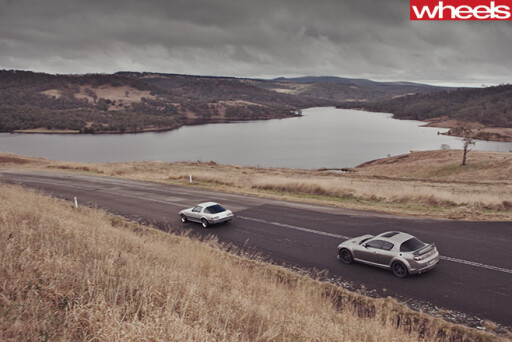 In 1979, the RX-7 was born, and German engineer Felix Wankel’s invention had found its place as a sports car engine. ‘Lightweight, rear-drive, front-mid-engined sports coupe’ might make you think of the Toyota 86 and Subaru BRZ today, but three decades ago it described the original RX-7. (Except that the RX-7 had a free-spinning, hand-built engine, not a family-car-derived four). In the late ’70s – and, for me, as a newly-licensed driver in the late ’90s – what else was there that met this description and fell within a realistic budget?
In 1979, the RX-7 was born, and German engineer Felix Wankel’s invention had found its place as a sports car engine. ‘Lightweight, rear-drive, front-mid-engined sports coupe’ might make you think of the Toyota 86 and Subaru BRZ today, but three decades ago it described the original RX-7. (Except that the RX-7 had a free-spinning, hand-built engine, not a family-car-derived four). In the late ’70s – and, for me, as a newly-licensed driver in the late ’90s – what else was there that met this description and fell within a realistic budget?
When I started at Wheels, with its succession of new, often high-performance cars, I hoped it wouldn’t render my old Mazda an object of the past. But if it did, what would it matter? I’d be living the dream in ultra high-performance metal that I didn’t have to pay for, right? Erm, not quite. If you’ll forgive the analogy, that would be like expecting meaning from a 15-minute relationship in The Cross…
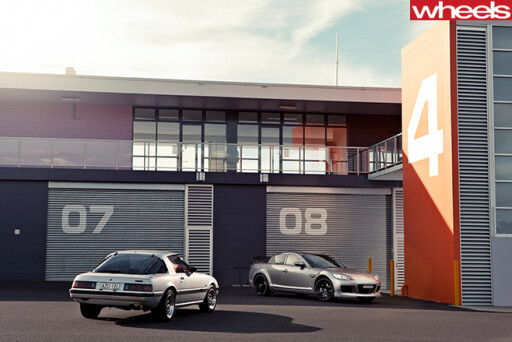 Rather, Wheels taught me that while there’s a correlation between price and performance, and that spending more usually gets you more power or a quicker lap time, more money doesn’t necessarily equal more fun. I still love driving my RX-7, despite all those quick flings.
Rather, Wheels taught me that while there’s a correlation between price and performance, and that spending more usually gets you more power or a quicker lap time, more money doesn’t necessarily equal more fun. I still love driving my RX-7, despite all those quick flings.
From the cocoon-like confines of the cabin, the original RX-7 feels light and simple. The driving position is right, but the seats are flat, and it’s all a bit ’80s-brown. The engine revs with uncanny smoothness, and kicks at 4000rpm as the carby’s vacuum-actuated secondaries open, sending the tacho towards – and beyond – the shift buzzer and 7000rpm redline with renewed conviction. The eagerness to rev, the loud, raspy exhaust, and the backfires and flames make it feel like a race car, but the reality is it’s not much quicker than a Mazda 2.
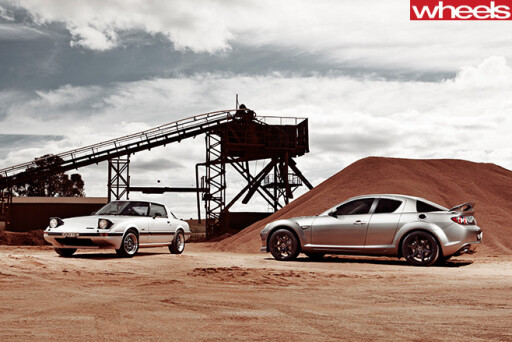 Modifications make my 1983 Series II a bit better than a stock one: the double-barrel exhaust tips look original, but the system is made from stainless steel and flows (and sounds) far better. Bigger, hi-po 205/50R15 rubber improves the stance and grip but means the chassis won’t play like it would on the stock 185/70R13s.
Modifications make my 1983 Series II a bit better than a stock one: the double-barrel exhaust tips look original, but the system is made from stainless steel and flows (and sounds) far better. Bigger, hi-po 205/50R15 rubber improves the stance and grip but means the chassis won’t play like it would on the stock 185/70R13s.
Normally, excellent steering ranks highly on my list of desirable car attributes, but even with chassis tweaks, my RX-7’s unassisted recirculating-ball steering – razor-sharp by early RX standards – is heavy and imprecise compared with anything new-ish. I can live with that, because of the engine…
***
THE RX-8 – no longer on sale – was long gone from the Mazda Oz press fleet. “We’ve found an SP with a badge, a rear wing and a turbo – would that be okay?” Mazda enquired. You beauty, I thought – good luck prising it back from me. One of 10 built, the SP and its Garrett GT3582R turbo should huff, puff and blow away any lingering criticisms (from others) of a lack of torque.
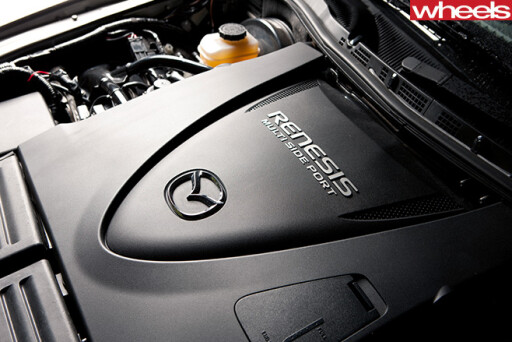 But first, I took a spin in long-time rotary mate Nathan’s 2005 Mazda RX-8 for a reminder of how the standard car drives. The low-rev flexibility surprised me; and at the other end of the tacho, the smoothness with which the 13B MSP engine spins to 9000rpm has to be experienced. Want rapid acceleration? Just drop three gears. The relatively modest torque figure doesn’t take away from the sports car experience, but that said, turbo boost would make it a better, more relaxed urban proposition. And a high-boost turbo (or multi-rotor) RX-8 would be a brilliant tool with which to hunt down Euro exotica.
But first, I took a spin in long-time rotary mate Nathan’s 2005 Mazda RX-8 for a reminder of how the standard car drives. The low-rev flexibility surprised me; and at the other end of the tacho, the smoothness with which the 13B MSP engine spins to 9000rpm has to be experienced. Want rapid acceleration? Just drop three gears. The relatively modest torque figure doesn’t take away from the sports car experience, but that said, turbo boost would make it a better, more relaxed urban proposition. And a high-boost turbo (or multi-rotor) RX-8 would be a brilliant tool with which to hunt down Euro exotica.
Allan Horsley, recently retired boss of Mazda Motorsport, thought so too. His RX-8 Motorsport was originally conceived as a 2004 Sydney motor show special to generate interest around the then-new rotary. It grew, via our road-going proto, into the flame-belching Targa Tasmania SP, which proved a close match for the outright class Gallardo, Godzilla, et al, in 2011 and ’12.
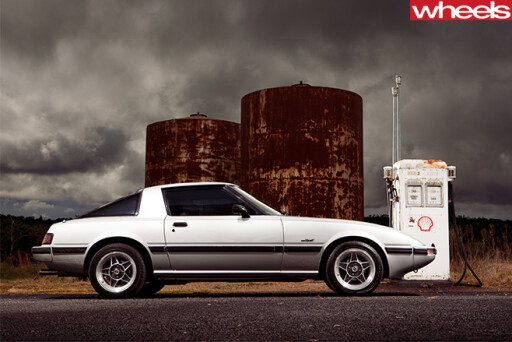 He’d seen the same potential in the twin-turbo third-generation RX-7 20 years earlier. His RX-7s finished first and fifth in the inaugural Bathurst 12-hour in 1992, and beat the Porsche 968 CS pair home twice with a one-two in 1993 and a third victory in ’94. For the 1995 12-hour, this time at Sydney’s Eastern Creek Raceway, Mazda pitched its purpose developed RX-7 SP into battle with Porsche’s 911 RSCS and won, again.
He’d seen the same potential in the twin-turbo third-generation RX-7 20 years earlier. His RX-7s finished first and fifth in the inaugural Bathurst 12-hour in 1992, and beat the Porsche 968 CS pair home twice with a one-two in 1993 and a third victory in ’94. For the 1995 12-hour, this time at Sydney’s Eastern Creek Raceway, Mazda pitched its purpose developed RX-7 SP into battle with Porsche’s 911 RSCS and won, again.
As a teenage rotary fan I was enthused by the dominance of the twin-turbo RX-7s, but I was a bit too young to watch Allan Moffat and his RX-7 making life difficult for Group C Commodores and Falcons in Australian tin-top racing. He drove the flared, noisy, aggro RX-7 to victory in the 1983 Australian Touring Car Championship and gave Mazda its best Bathurst 1000 result – second – the same year.
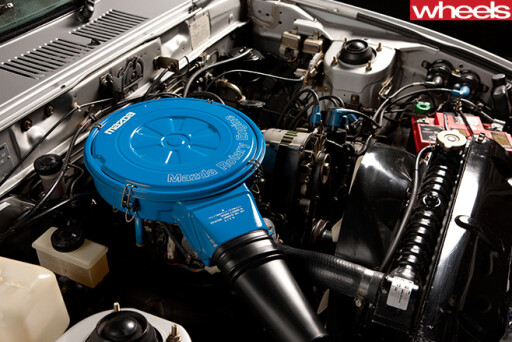 However, the rotary’s reliability and speed was far from a new phenomenon on the global stage. In 1968, at the 84-hour Marathon de la Route at the Nürburgring, a pair of Cosmo Sport coupes ran fourth and fifth for much of the race, finishing with fourth place for one and a late retirement for the other due to axle damage. A year later, a pair of R100 coupes finished fifth and sixth behind a quartet of 911s at the Spa 24-hours, and an R100 finished fifth in the Marathon de la Route.
However, the rotary’s reliability and speed was far from a new phenomenon on the global stage. In 1968, at the 84-hour Marathon de la Route at the Nürburgring, a pair of Cosmo Sport coupes ran fourth and fifth for much of the race, finishing with fourth place for one and a late retirement for the other due to axle damage. A year later, a pair of R100 coupes finished fifth and sixth behind a quartet of 911s at the Spa 24-hours, and an R100 finished fifth in the Marathon de la Route.
However, the rotary’s sweetest victory came in the 1991 Le Mans 24-hour, where the naturally aspirated, quad-rotor R26B-powered 787B beat the Walkinshaw Jaguars on the way to becoming the only Japanese maker (and only non-reciprocating engine) to win the French classic.
***
DRIVING THE RX-8 SP reignited a personal debate that I thought I’d resolved when I bought my current RX-7: Which is the ultimate, atmo or turbo rotary power? Of my seven rotaries three were atmo, three were turbo, and one started out carburetted before being injected and turbocharged. It’s a difficult decision: the purity and linearity of the rotary torque curve and exhaust note are preserved with atmospheric induction. But the appeal of an engine that revs hard, spinning a turbo at high speeds with its forceful exhaust, which in turn forces air into the engine is … powerful. The Targa Tassie SP is rumoured to produce 300kW.
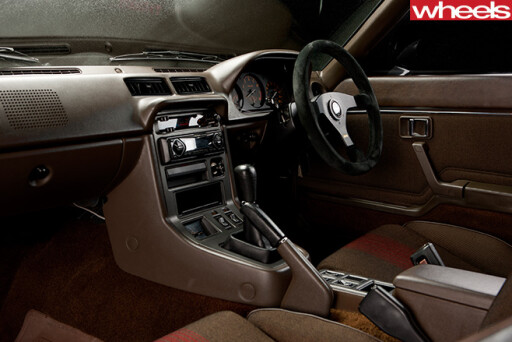 The road version doesn’t have that much, but recorded times a second or more quicker than a standard one – 5.7sec 0-100km/h and 13.9sec 0-400m – when John Carey tested a different SP proto in Wheels September ’05. The brilliant thing about the boosted RX-8 is the extra snail-assisted mid-range shove, which means that big revs are there for the thrill factor, rather than being a prerequisite for quick progress in a car that’s a bit on the heavy side for an atmo 13B. The high-flowing turbo smooths the exhaust rasp into a deliciously cultured iteration of the twin-rotor howl, and the power delivery and lust for revs remain.
The road version doesn’t have that much, but recorded times a second or more quicker than a standard one – 5.7sec 0-100km/h and 13.9sec 0-400m – when John Carey tested a different SP proto in Wheels September ’05. The brilliant thing about the boosted RX-8 is the extra snail-assisted mid-range shove, which means that big revs are there for the thrill factor, rather than being a prerequisite for quick progress in a car that’s a bit on the heavy side for an atmo 13B. The high-flowing turbo smooths the exhaust rasp into a deliciously cultured iteration of the twin-rotor howl, and the power delivery and lust for revs remain.
Thank the engine, too, for the fact that the RX-8 is one of the best handling cars this side of the mega-buck exotics. More than any RX-7, it wraps the benefits of that small, light, front-mid-mounted engine in a terrifically well-sorted chassis. The electro-mechanical steering is slick and accurate, the balance and adjustability are sublime, and it does it without stiff springs and dampers, which allows it to glide over rough roads. Some of that compliance is lost in the RX-8 GT, introduced with the updated 2008 model, which brought stiffer Bilstein suspension, even greater dynamic capability, and another conundrum for me…
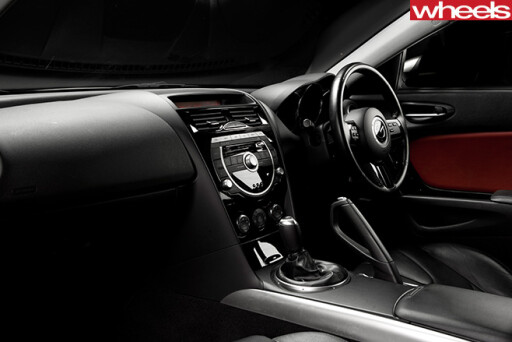 As the owner of a 1991 RX-7 turbo at the time, I greeted the 2003 arrival of the RX-8 with mixed feelings. The twin-turbo RX-7 had last sold in Oz in 1998 (2002 in Japan), so the new arrival meant that it was again possible to buy a brand-new rotary – terrific. It was difficult to believe that the boldness of the RX-Evolv concept lived in a semi-affordable production sports car with room for the family. But it shouldn’t have been – this was Mazda, the car maker that had persisted with and made a success of the Wankel engine where others had failed. However, gone were the RX-7’s focus, its two-door-cool and turbo thrust.
As the owner of a 1991 RX-7 turbo at the time, I greeted the 2003 arrival of the RX-8 with mixed feelings. The twin-turbo RX-7 had last sold in Oz in 1998 (2002 in Japan), so the new arrival meant that it was again possible to buy a brand-new rotary – terrific. It was difficult to believe that the boldness of the RX-Evolv concept lived in a semi-affordable production sports car with room for the family. But it shouldn’t have been – this was Mazda, the car maker that had persisted with and made a success of the Wankel engine where others had failed. However, gone were the RX-7’s focus, its two-door-cool and turbo thrust.
Today, those mixed feelings are gone. The RX-8 handles better, and is both more fun and more practical than any RX-7 since the original. Here’s hoping that its Renesis 13B doesn’t turn out to be the last rotary. Either way, it will be the last built around core dimensions that date back to the original Cosmo 10A engine, and that, among other qualities, marks it as a modern classic.
There’s an RX-8 in my future, but what does its maker’s future hold? I can only hope there’s a rotary in it. It’s as important to Mazda’s identity as it is to mine.

COMMENTS